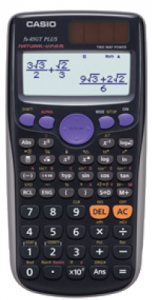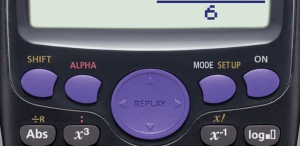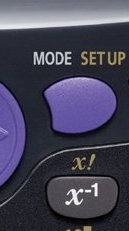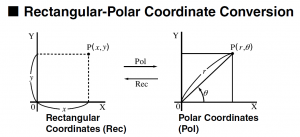
Whilst working with the Police Crash investigator team I had a meeting with Pete Monteith, now known as calculator Pete, whom I decided must be of a similar age to me, as he had the same calculator I’d had at school. The difference was, he was still using his, whilst I was enjoying the delights of an updated calculator.
These days calculators are more technical than the computers I was brought up with. However, I think fewer people know how to use them, which isn’t surprising given the poor quality of the instruction manual. I am on a one woman campaign to get my students to fully utilise this great resource. When I started teaching Physics it used to take two weeks to teach resistance in parallel, now the students are happy in under a lesson- the reason? Their calculators “do as it says on the tin”!
Here are a few things to check out and try. (I am using a Casio, and I know the brighter amongst you would much prefer a Sharp, but I’ve never got on with them). You can draw your own conclusions!
Let’s check out using the calculator how to find total resistance in parallel. The equation is
1/Rt = 1/R1 + 1/R2 + 1/R3… etc.
How can your calculator to do this easily?
Let’s try adding a 7 ohm resistor in parallel with a 28 ohm resistor.
- Make sure your calculator is in MATHS IO mode. To do this go SHIFT -> MODE->1. I’ll assume you know to turn it on.

- Press the fraction button, two rectangles one on top of the other with a line between. (see image below)

- Now type in the first value which will be 1/7 (7 is the resistance but the equation tells us to find 1/Rt we need to put in the value of 1/R1)
- The up and down arrows allow you to move between the top and bottom parts of the fraction.
-

- Now we need to add the 1/28 to this value. Use the right arrow to make sure that you are out of the fraction.
- Press the + symbol.
- Then press the fraction button again and add in the 1/28, using the up and down arrows as before.
- Now when you press equals you ought to get the answer for 1/Rt, in this case 5/28.
- Remember this is not the answer. This is the value for 1/Rt. We need to find 1/ans to find the value Rt. Luckily we have a button for that too.
- Press the X-¹ button (see below)
 When you press the equals this gives the answer 28/5. This is indeed the right answer but the SQA does not like you leaving things as a fraction. So press the S<->D button to reveal the answer 5.6
When you press the equals this gives the answer 28/5. This is indeed the right answer but the SQA does not like you leaving things as a fraction. So press the S<->D button to reveal the answer 5.6- So adding a 7 ohm and a 28 ohm resistor in parallel gives a total resistance of 5.6 ohms.
Yes that really did take nearly two weeks to teach before the age of super calculators.
Remember, your calculator can be a great asset to you during your exam and your career but only if you know how to use it.
Here is another of my favourite buttons, the degrees, minutes and second button.
 With this button we can easily add times together and convert between time and decimals of time.
With this button we can easily add times together and convert between time and decimals of time.- For example, we all know that 2 hours 30 minutes is 2.5 hours so we’ll just use this to prove it works!
- With this button, you must remember that you have to enter a number for hours, minutes and seconds even if they are not needed.
- Enter 2 (for the hours) and press the
 . Then put in the 30 minutes and press the
. Then put in the 30 minutes and press the  button again.
button again. - Now two hours thirty minutes doesn’t have any seconds, but we need to input this into the calculator, so press 0 and the

- The odd bit, that is easily forgotten, is you now need to press the equals button which reveals 2°30°0°.
- Press the
 button and this gives 2.5. Well we knew that but other numbers aren’t so obvious.
button and this gives 2.5. Well we knew that but other numbers aren’t so obvious. - Try 0 hours, 45 mins and 0 seconds. Yes you ought to get 0.75 hours.
- But does it work the other way? Yes it does.
- Type in 0.75 press the equals and then push
 ;the calculator displays 0°45°0° or 45 minutes
;the calculator displays 0°45°0° or 45 minutes - You can add time too. Try adding 3 hours 49 minutes to 7 hours 25 minutes. This will tell me the time I will be at Euston Station if I catch the 7:25 train to London, which takes 3 hours and 49 minutes. Now I could just check the timetable or I can use the calculator and I rapidly find I will be in London at 11:14am (or I will if the train is on time: and if it is over half an hour late, remember to reclaim your train fare)
My final fun button that is now a favourite of my classes, although they are right to be a little nervous, if they don’t know what they are doing. These tips cut the time to find resultants or components of vectors and their angles. The teaching of SOHCAHTOA (which incidentally I have to spell out using Six Old Horses, Clumsy And Heavy, Trod On Albert because I can’t spell SOHCAHTOA) appears to have gone by the wayside in Maths. But once you know your Pythagoras and SOHCAHTOAs from other Greek Philosophers then this button can save loads of time, but please don’t use it unless you’re sure you know what you’re doing.

I am sure many of you know that a right angled triangle with sides 3cm and 4cm will have a hypotenuse (or large side) of 5cm, but what will the angle be between the X axis and hypotenuse?
For this we want to use the rectangular to polar coordinate buttons.

We want to find the hypotenuse of a 3,4 triangle and the angle it subtends. so therefore we need the Pol button.
- Press shift and then +, this causes a Pol( to appear on your screen.
- Enter 4 for along the bottom and then a comma ( which is shift and close brackets) ie shift )
- Then add the second digit, the 3 up.
- Close the brackets or just press equals.
- This gives an r=5, θ = 36.86989765 , which you’d certainly know to round up to 37°.
- If you know the 5cm and the angle, just use the Rec button (shift and the minus).
- So Rec(5,37) =X=3.99317755, Y=3.009075116, which for a Physicist is fine as 4cm along and 3cm up!
Practice using these buttons and when you need some more handy calculator hints let me know!
To Calculator Pete, if you ever want a race, I’ll time you with your factorial button anytime! When I was at school my Casio beat my friends Texas calculator by about 45 seconds every time I pressed 69 and then the factorial button (!). This then multiplied 69 by 68,by 67 etc. all the way down to 1. Funny, my new super calculator can still only manage factorials up to 69 before running out of digits, but the speed is remarkable. My question to myself, is why did me and my friend Deb Faulder, ever race regularly- as if we expected one day her calculator to beat mine.
![]()

